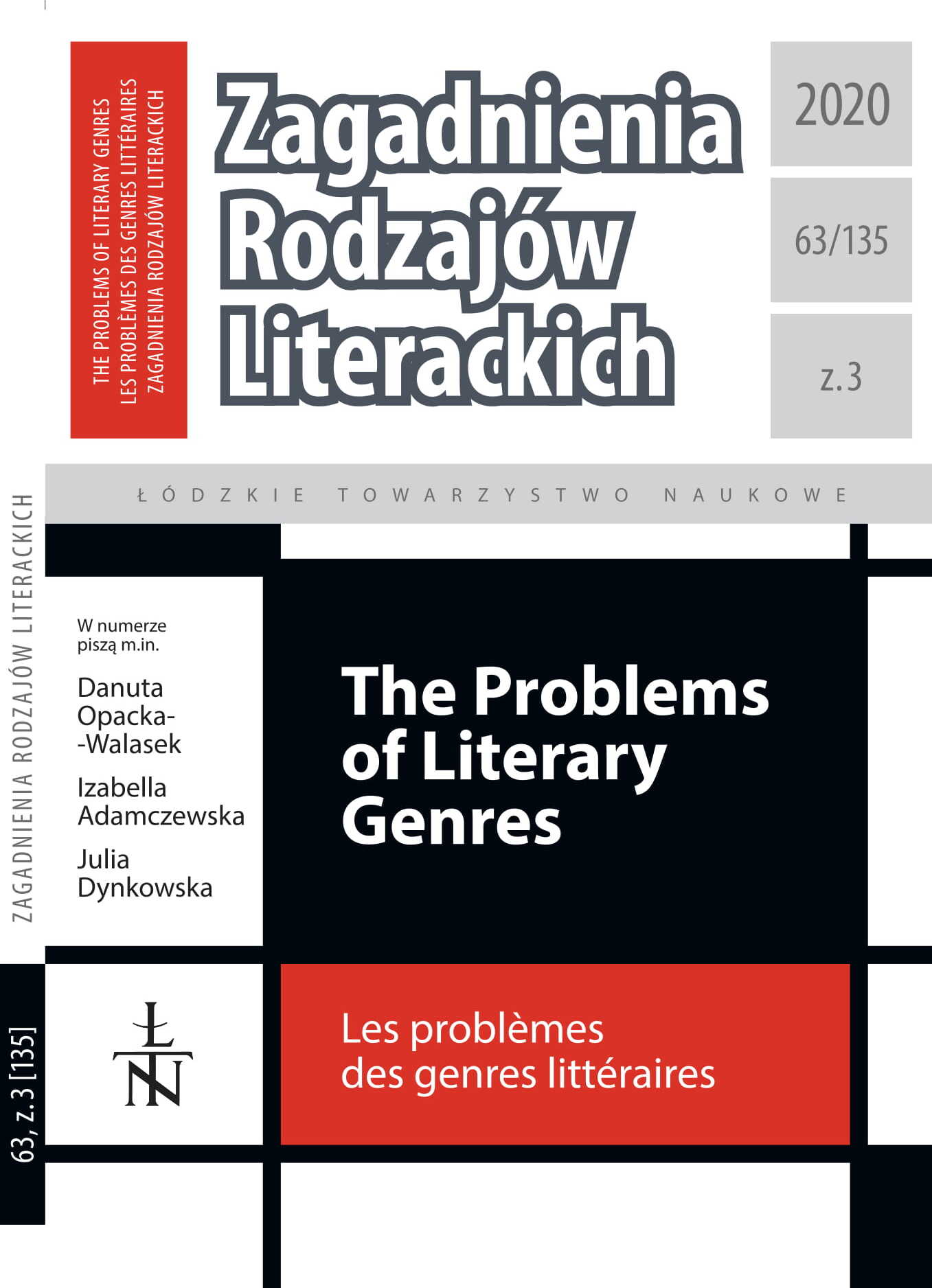Virocentric Documentary Narratives with Themes of „Dark Biology”
DOI:
https://doi.org/10.26485/ZRL/2020/63.3/1Keywords:
nonfiction, ecocriticism, virocentric narratives, pandemic literatureAbstract
This paper discuses an eco-apocalyptic non-fiction, which can be described as dark biology (referring to dark fantasy, dark science-fiction or noir crime fiction). The analysis is focused on Richard Preston’s, David Quamenn’s, Karl Taro Freenfeld’s and Nathan Wolfe’s medical/scientific nonfiction and heroic-exploratory narratives. The authors of dark narratives about viruses use the motives typical of crime, thriller, horror or sensation fiction. This analysis is set in a context of „dark ecology” — Timothy Morton’s eco-critical project.
Downloads
References
Teksty analizowane
Greenfeld Karl Taro (2006), China Syndrome. The True Story of the 21st Century’s First Great Epidemic [ebook].
Preston Richard (2002), The Demon in the Freezer. A True Story, Random House, New York.
— (2012), Panic in Level Four. Cannibals, Killer Viruses, and Other Journeys to the Edge of Science [ebook], Random House.
— (2015), Strefa skażenia, przeł. J. Kuryłowicz, SQN, Krakow.
Quammen David (2013), Spillover. Animal Infections and the Next Human Pandemic, W.W. Norton & Company, New York–London.
— (2014), Ebola. Tropem zabójczego wirusa, przeł. K. Mojkowska, Muza, Warszawa.
— (2015), The Chimp and the River. How Aids Emerged from an African Forest, W.W. Norton & Company, New York–London.
Wolfe Nathan (2011), The Viral Storm. The Dawn of a New Pandemic Age, Times Books, Henry Holt and Company, New York.
Literackie konteksty i bibliografia przedmiotowa
Barcz Anna (2018), Przedmioty ekozagłady. Spekulatywna teoria hiperobiektów Timothy’ego Mortona i jej (możliwe) ślady w literaturze, „Teksty Drugie”, nr 2, s. 75–87.
Boynton Robert S. (2005), The New New Journalism. Conversations with America’s Best Nonfiction Writers on Their Craft, Vintage Books, New York.
Clark Timothy (2011), The Cambridge Introduction to Literature and the Environment, Cambridge UP, Cambridge.
Cooke Jennifer (2009), Legacies of Plague in Literature, Theory and Film, Palgrave Macmillan, New York.
Domańska Ewa (2013), Humanistyka ekologiczna, „Teksty Drugie”, nr. 1–2, s. 13–23.
El Zowalaty Mohamed E., Young Sean G., Jarhult Josef D. (2020), Environmental impact of the COVID-19 pandemic — a lesson for the future, „Infection Ecology & Epidemiology”.
Greenhough Beth (2012), Where species meet and mingle: endemic human-virus relations, embodies communication and more-than-human agency at the Common Cold Unit 1946–90, „Cultural Geographies”, nr 19 (3), s. 281–301.
Gifford Terry (2013), Pastoral, Anti-Pastoral, and Post-Pastoral [w:]The Cambridge Companion to Literature and the Environment, red. Westling L., Cambridge UP, Cambridge, s. 17–30.
Głowiński Michał (1982), Dokument jako powieść [w:] Studia o narracji, red. Błoński J., Sławiński J., Jaworski J., Ossolineum, Wrocław.
Gruen Lori (red.) (2018), Critical Terms of Animal Studies, The University of Chicago Press, Chicago–London.
Haraway Donna (2012), Manifest gatunków stowarzyszonych, przeł. J. Bednarek [w:] Teorie wywrotowe. Antologia przekładów, red. Gajewska A., Wydawnictwo Poznańskie, Poznań, s. 241–260.
Marzec Andrzej (2018), „Jesteśmy połączonym z sobą światem” i Timothy Morton i widmo innej wspólnoty, „Teksty Drugie”, nr 2, s. 88–101.
Morgan Jack (2002), Biology and Horror: Gothic Literature and Film, Southern Illinois UP, Carbondale–Edwardsville.
Morton Timothy (2009), Ecology Without Nature. Rethinking Environmental Aesthetics, Harvard UP, London.
— (2016), Dark Ecology. For a Logic of Future Coexistence, Columbia UP, New York.
Rohwer Forest, Barott Katie (2013), Viral information, „Biology and Philosophy”, nr 28, z. 2, s. 283–297.
Schneider Richard (red.) (2016), Dark Nature. Anti-Pastoral Essays in American Literature and Culture, Lexington Books, Lanham–Boulder–New York–London.
Schweitzer Dalia (2018), Going Viral. Zombies, Viruses and The End of The World, New Brunswick, Rutgers UP, Newark–Camden–New Jersey–London.
Lowenhaupt Tsing Anna (2015), The Mushroom at the End of the World. On the Possibility of Life in Capitalist Ruins, Princeton UP, Princeton–Oxford.
— (2018), Krnąbrne krawędzie: grzyby jako gatunki towarzyszące, przeł. M. Rogowska-Stangret [w:] Feministyczne nowe materializmy: usytuowane kartografie, red. Cielemęcka O., Rogowska-
Stangret M., E-naukowiec, Lublin, s. 71–88.
Ubertowska Aleksandra (2018), „Mówić w imieniu biotycznej wspólnoty”. Anatomie i teorie tekstu środowiskowego/ekologicznego, „Teksty Drugie”, nr 2, s. 17–40.
Wells Herbert George (2017), Wojna światów, przeł. S. Barszczewski, Ktoczyta.pl [ebook].
Wieczorkiewicz Anna (2009), Monstruarium, słowo/obraz terytoria, Gdańsk.
Žižek Slavoj (2020), PANDEMIC!: Covid-19 Shakes the World [ebook], OR Books.







